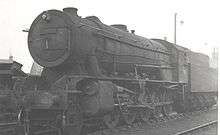WD Austerity 2-10-0
|
90775 on the North Norfolk Railway. Despite having the appearance of a British Railways locomotive, the highest numbered BR engine was 90774, and this example was repatriated from Greece. | |||||||||||||||||||||||||||||||||||||||||||||||||||
| |||||||||||||||||||||||||||||||||||||||||||||||||||
| |||||||||||||||||||||||||||||||||||||||||||||||||||
| |||||||||||||||||||||||||||||||||||||||||||||||||||
| |||||||||||||||||||||||||||||||||||||||||||||||||||
The War Department (WD) "Austerity" 2-10-0 is a type of heavy freight steam locomotive that was introduced during the Second World War in 1943.
Background
The Austerity 2-10-0 was based on the Austerity 2-8-0, and was designed to have interchangeable parts by R.A. Riddles. It had the same power output as the 2-8-0 but a lighter axle load, making it suitable for secondary lines.
Design
It had a parallel boiler and round-topped firebox. While the 2-8-0 had a narrow firebox, the 2-10-0 had a wide firebox placed above the driving wheels. This arrangement was common in the United States (e.g. the USRA 0-8-0) but unusual in Britain. In Britain, wide fireboxes were usually used only where there was a trailing axle, e.g. in 4-4-2 and 4-6-2 types. One exception was the GER Decapod.
These were the first 2-10-0 locomotives to work in Great Britain, and the first major class of ten-coupled engines — they had been preceded by two 0-10-0 locomotives; the Great Eastern Railway's Decapod and the Midland Railway's Lickey Banker.
The 2-10-0 wheel arrangement was later used by Riddles when he designed the BR standard class 9F. This, too, had a wide firebox placed above the driving wheels.
Construction
Two batches were built by the North British Locomotive Company, the first batch of 100 introduced in 1943/1944 and the second batch of 50 in 1945. Their WD Nos were 3650–3749 (later 73650–73749), and 73750–73799.
20 of the first batch were sent to the Middle East. During running-in they worked in Britain, but their length made them unsuitable. Most saw service with the British Army in France after D-Day.
Post-war service
After the war the 150 locomotives were distributed as follows, the majority going to the Netherlands:
| No. of engines | Country | Company | Class |
|---|---|---|---|
| 103 | Netherlands | Nederlandse Spoorwegen (NS) | NS 5000 class |
| 25 | Great Britain | British Railways (BR) | BR ex-WD Austerity 2-10-0 |
| 16 | Greece | Hellenic State Railways (SEK) | SEK Class Λβ |
| 4 | Syria | Chemins de Fer Syriens (CFS) | CFS Class 150.6 |
Netherlands
In 1946, the Netherlands bought those in continental Europe. They formed the NS 5000 class, and were numbered 5001-103. They had a short working life, the last being withdrawn in 1952.
British Railways
After the war, the British Railways (BR) bought twenty-five locomotives. These were initially numbered 73774-73798 but later re-numbered 90750-74. They were mostly operated by BR's Scottish Region on heavy freight trains and were all withdrawn between 1961 and 1962.
 ex-WD 2-10-0 No. 73798 'North British' stands at Motherwell Depot in 1948
ex-WD 2-10-0 No. 73798 'North British' stands at Motherwell Depot in 1948 BR Scottish Region WD 2-10-0 90768 at Motherwell motive power depot in 1958
BR Scottish Region WD 2-10-0 90768 at Motherwell motive power depot in 1958 WD 2-10-0 WD 601 "Kitchener" at Carlisle Kingmoor BR shed in 1958. Note air pumps, headlight and nameplate
WD 2-10-0 WD 601 "Kitchener" at Carlisle Kingmoor BR shed in 1958. Note air pumps, headlight and nameplate
Greece
Sixteen of the twenty Middle East locomotives went to Greece, where they formed Class Λβ of the Hellenic State Railways, numbered Λβ951 to Λβ966.
Syria
The remaining 4 Middle East locomotives remained in Syria and operated on the Chemins de Fer Syriens (CFS). These engines formed the CFS Class 150.6.
Further WD services
In the 1952 WD renumbering scheme, the two remaining in WD service (at the Longmoor Military Railway), Nos. 73651 and 73797, were renumbered 600 and 601 respectively. The also received names: 600 Gordon and 601 Kitchener.
Preservation
LMR 600 Gordon has survived and has been steamed on the Severn Valley Railway, though as of 2005 it is out of service, cosmetically restored and on display in the Engine House.
Two more have been repatriated from Greece. One has been numbered 90775, one higher than the last BR engine, and has carried the name Sturdee (as WD/LMR No. 601 before being numbered 90775). Under overhaul on North Norfolk Railway. The other is WD No. (7)3672 which has been named Dame Vera Lynn. The loco is currently awaiting overhaul at Grosmont, NYMR.
The 4th one in preservation WD 73755 (NS 5085) survives in the Dutch Railway Museum (Nederlands Spoorwegmuseum) in Utrecht. It carried the nameplate Longmoor, after the Royal Engineer's base at Longmoor, with the coat of arms of the Royal Engineers above.
| Numbers | Name | Location | ||||
|---|---|---|---|---|---|---|
| WD | NS | SEK | BR | LMR | ||
| (7)3651 | — | — | — | 600 | Gordon | On display in the Engine House, Severn Valley Railway, England |
| (7)3652 | — | Λβ951 | 90775* | — | Sturdee* (name not currently carried)[1] | Undergoing overhaul, North Norfolk Railway, Norfolk, England |
| (7)3672 | — | Λβ960 | — | — | Dame Vera Lynn* | Awaiting overhaul at Grosmont North Yorkshire Moors Railway, Yorkshire, England |
| 73755 | 5085 | — | — | — | Longmoor | Nederlands Spoorwegmuseum, Utrecht, Netherlands |
* Name or number applied after preservation
Notes and references
- ↑ after Doveton Sturdee
Further reading
- Boddy, M. G.; Brown, W. A.; Neve, E.; Yeadon, W. B. (November 1983). Fry, E. V., ed. Locomotives of the L.N.E.R., Part 6B: Tender Engines—Classes O1 to P2. Kenilworth: RCTS. ISBN 0-901115-54-1.
- Tourret, R. (1995). Allied Military Locomotives of the Second World War. Abingdon, Oxon: Tourret Publishing. ISBN 0-905878-06-X.
- Rowledge, J. W. P. Heavy Goods Engines of the War Department: Vol. 3 – Austerity 2-8-0 and 2-10-0.
External links
| Wikimedia Commons has media related to WD Austerity 2-10-0. |
